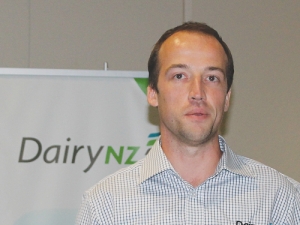Farmers and catchment groups leading the next wave of freshwater restoration
From nitrogen limits to ecosystem restoration –farmers and catchment groups are leading a new wave of environmental care, says DairyNZ.
 DairyNZ water specialist Tom Stephens says emotions and values now dominate decisions on water quality.
DairyNZ water specialist Tom Stephens says emotions and values now dominate decisions on water quality.
Emotions and values now come first in water quality assessment and science comes second, says a water quality specialist with DairyNZ, Tom Stephens.
But that is not necessarily bad for farmers: under changes to water quality assessment that quality is based on what the community wants. Farmers are part of that community and can have a say, he told the DairyNZ Farmers Forum in Northland.
“In the past, science came first and it has been disconnected from what the community wants,” says Stephens. “So the Government has flipped it on its head and said communities are now driving limit setting.”
Councils are setting up stakeholder groups and it is a “once in a lifetime” opportunity to have a say. “You guys get to set the rules. If you sit outside, you get what you are given,” Stephens told the forum.
Under the National Policy Statement for Freshwater Management, released last year, water quality is now defined on the basis of community values. Regional councils must set precise environmental limits to at least two values nationwide – ecosystem and human health.
“All the values aside, it is whether that waterway is fit for you (the community) to do what you want to do with it,” Stephens explains.
“If you are a farmer that is to farm, if you are local iwi that might be mihinga kai, if you are a hydro-electric plant it might the generation of power. All these things are balanced and you as a businessman or you as an individual have a range of values that need to be protected.
“Provided it is good enough to do what you want to do with it – its quality is good.
“What it means is the science is secondary because [an equal] number of, say, E.coli in that water may be bad in terms of swimming or fine in terms of hydro-electricity generation.”
The National Policy Statement is the directive from the Government to set water quality limits in each community. The plans must be in place by 2025. “The limits don’t have to be met by 2025 but you have to have a plan in place that will say by a set date that water quality will be good enough for the community.”
You need limits if your water quality is already good enough. If it is not you need targets to get back to the accepted quality within that community.
“If the water quality isn’t good enough for you to pursue your practices now but the community want them to be on the balance of consideration and consensus, then you need to put in place some framework by which you can claw back… to make that waterway good enough.”
Nutrients are one of the principle inadvertent outputs of a dairy system, particularly nitrogen but also phosphorus. There are also E.coli and sediments.
The core values in the National Policy Statement are ecosystem health and human health. But other values come in: for hydro-electricity you need flow; for gathering food on waterways you have to take into account E.coli.
Under the National Objectives Framework there is a score card for values – A, B, C and D. The guidelines show the community what can be measured, whether a value is being met and what grade can be assigned to those attributes.
For instance, A grade is good enough for swimming – 1:100 users might get ill from swimming; B grade, 1:20 users might get ill. C grade, it is not good enough to swim, but it is good enough for wading, fishing or boating. D grade is unacceptable: there is a minimum that must be met.
Swimming in New Zealand is in a clearly defined period from about November to April. So test results from this period or during heavy rainfalls could be presented by environmental lobbyists which could distort the picture.
A New Zealand dairy industry leader believes the free trade deal announced with India delivers wins for the sector.
The Coalition Government will need the support of at least one opposition party to ratify the free trade deal with India.
Primary sector leaders have welcomed the announcement of a Free Trade Agreement between India and New Zealand.
At Pāmu’s Kepler Farm in Manapouri, mating has wrapped up at the across-breed Beef Progeny Test.
More than 150 people turned up at Parliament recently to celebrate the 20th anniversary of Horticulture New Zealand (HortNZ).
Biosecurity New Zealand says Kiwis should continue to keep an eye out for yellow-legged hornets (Vespa velutina) over the holiday season.

OPINION: The release of the Natural Environment Bill and Planning Bill to replace the Resource Management Act is a red-letter day…
OPINION: Federated Farmers has launched a new campaign, swapping ‘The Twelve Days of Christmas’ for ‘The Twelve Pests of Christmas’ to…